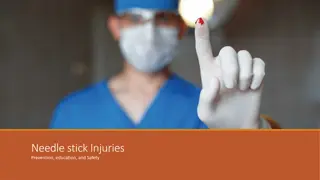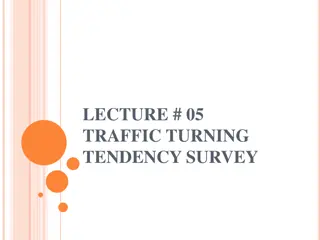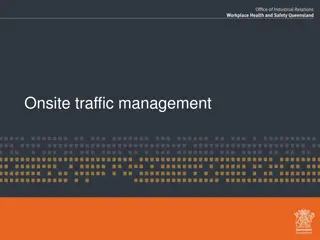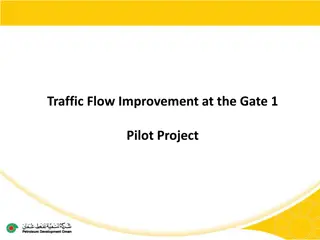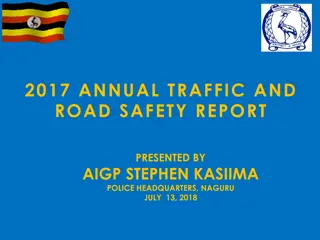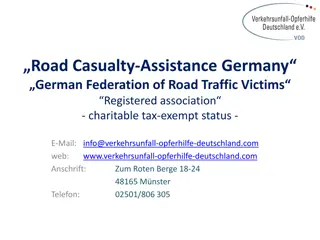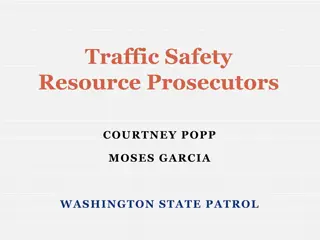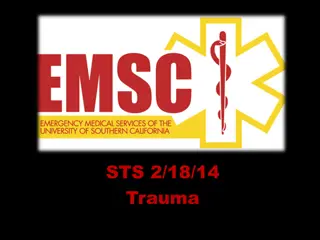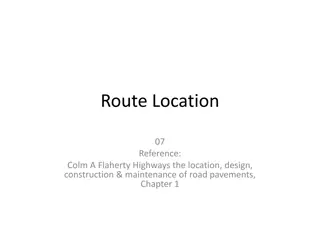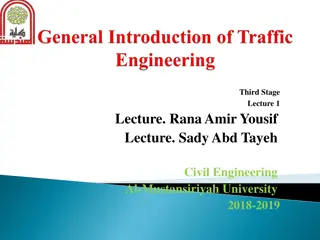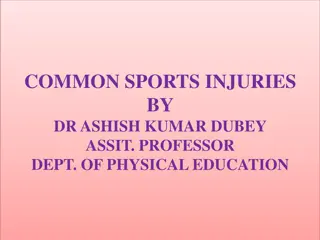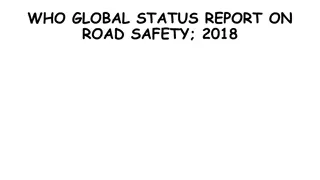Preventing Road Traffic Injuries: A Global Perspective
Road traffic injuries are a significant global issue, causing millions of deaths and injuries annually. This report highlights the complexity and dangers of road traffic systems, emphasizing the need for increased awareness and preventive measures at governmental, industrial, and individual levels. The economic impact of road crashes is substantial across different income levels, stressing the importance of injury prevention to reduce costs and mitigate the burden on healthcare systems. In Saudi Arabia, road traffic accidents are a major concern, with speeding being a common cause and non-compliance with safety measures contributing to the high number of injuries. The health sector plays a crucial role in injury surveillance, policy implementation, and intervention evaluation to address road traffic injury prevention effectively.
Download Presentation

Please find below an Image/Link to download the presentation.
The content on the website is provided AS IS for your information and personal use only. It may not be sold, licensed, or shared on other websites without obtaining consent from the author. Download presentation by click this link. If you encounter any issues during the download, it is possible that the publisher has removed the file from their server.
E N D
Presentation Transcript
WORLD REPORT ON ROAD TRAFFIC WORLD REPORT ON ROAD TRAFFIC INJURY PREVENTION INJURY PREVENTION Done by: 1. Trad Alwakeel 436101868 2. Saqr Altamimi 3. Faisal Abdullah Alharbi. 4. Abdullah Alnasser 435108397 5. Abdulrahman Zekry 435101869 6. Abdulaziz Alhothali 436100319 7. Moaid Alyousef 435104339 8. Abdulaziz Alzaydan 435102849 9. Abdulkarim Almuhaydily 435106497 436105099 435102390
INTRODUCTION INTRODUCTION OF ALL THE SYSTEMS WITH WHICH PEOPLE HAVE TO DEAL EVERY DAY, ROAD TRAFFIC SYSTEMS ARE THE MOST COMPLEX AND THE MOST DANGEROUS. WORLDWIDE, AN ESTIMATED 1.2 MILLION PEOPLE ARE KILLED IN ROAD CRASHES EACH YEAR AND AS MANY AS 50 MILLION ARE INJURED, MORE THAN 3000 PEOPLE DIE FROM ROAD TRAFFIC INJURY EVERYDAY. THE LEVEL OF ROAD TRAFFIC INJURY IS UNACCEPTABLE AND THAT IT IS LARGELY AVOIDABLE BY CREATION A GREATER LEVELS OF AWARENESS AT THE LEVEL OF GOVERNMENT (SPEED CAMERAS), INDUSTRIES (SAFER ROAD TRAFFIC SYSTEMS) AND INDIVIDUALS (EDUCATION). THE ECONOMIC COST OF ROAD CRASHES AND INJURIES IS ESTIMATED TO BE 1% OF GROSS NATIONAL PRODUCT (GNP) IN LOW-INCOME COUNTRIES, 1.5% IN MIDDLE-INCOME COUNTRIES AND 2% IN HIGH- INCOME COUNTRIES. IT ALSO CONSIDERED AS A HEAVY BURDEN, ON GLOBAL AND NATIONAL ECONOMIES, AND HOUSEHOLD FINANCES. THE HEALTH SECTOR WOULD GREATLY BENEFIT FROM BETTER ROAD TRAFFIC INJURIES PREVENTION IN TERMS OF FEWER HOSPITAL ADMISSIONS AND A REDUCED SEVERITY OF INJURIES WHICH WILL REDUCE THE COSTS.
THE MAGNITUDE OF THE PROBLEM THE MAGNITUDE OF THE PROBLEM IN SAUDI ARABIA IN SAUDI ARABIA Road traffic accidents accounted for 83.4% of all trauma admissions in 1984-1989. Excessive speeding was the most common cause reported in all recent and past studies. An audit of RTAs over a one-year period revealed that, out of 361 victims, 16% were under 10 years and 47% between 11 and 30 years. None of those involved in accidents was wearing a seat belt. Half of the children injured were pedestrians. There was a male to female ratio of 4:1 reflecting the driving laws in Saudi Arabia.
1. 1. ROLE OF THE HEALTH SECTOR: ROLE OF THE HEALTH SECTOR: Health sectors has important roles to play. These include: 1- Discovering, through injury surveillance and surveys, as much as possible about all aspects of road crash injury. 2- Translating effective science-based information into policies and practices that protect pedestrians, cyclists and the occupants of vehicles. 3- Helping to implement interventions that appear promising, especially in the area of human behavior, disseminating information on the outcomes, and evaluating the cost-effectiveness of these programs.
2. 2. The new model: The new model: The role of government in the new model of improving safety of traffic system: o Historically, governmental responsibilities for traffic safety fall within multiple government departments such as police, justice, health, planning and education. o Experience of several countries indicates that effective strategies for reducing traffic injury have a greater chance of being applied if there is a separate government agency with the power and budget to plan and implement its program. The role of Research in the new model of improving safety of traffic system: o research contributes to identify interventions that can protect vulnerable road users, with special attention to interventions. The role of Involvement of industry in the new model of improving safety of traffic system: o Industry shares responsibility for road safety by designing and selling vehicles and other products. The role of Nongovernmental organizations in the new model of improving safety of traffic system: o Non-governmental organizations promote road safety by publicizing the problem of road traffic injury, identifying effective solutions, challenging ineffective policies and forming alliance to improved road safety, initiation of Trauma care centers which give the best possible post-crash care for injured people.
3. 3. Achieving better performance: Achieving better performance: The role of Sharing responsibility in Achieving better performance: o Road safety is best achieved when all the key groups identified earlier share a culture of road safety. o When there is a culture of road safety, the providers and enforcers of road traffic systems (vehicle manufacturers, road traffic planners, road safety engineers, police, health professionals and insurers) take responsibility for ensuring that their products and services meet the highest possible standards for road safety. The role of Setting targets in Achieving better performance: o Several studies have shown that setting targets for reducing the incidence of road traffic injury can improve road safety programs by motivating everyone involved to make optimal use of their resources. o Targets encourage people to identify all possible interventions, to rank them according to the impact they are proven to have on the incidence of injury and to implement the ones that are most effective. The role of Building partnerships in Achieving better performance: o The United Kingdom Department for Transport encourages local partnerships in which the department and local authorities, police, courts and sometimes health authorities work together on enforcing speed limits and recovering the costs of this. o Over the first two years, pilot studies launched in 2000 have reduced the incidence of road crash by 35% and the incidence of fatal and serious injury to pedestrians by 56%.The savings on administering services to road crash survivors have freed up about 20 million to be invested in other ways. The economic benefit to society is estimated to be about 112 million.
4. 4. The global impact: The global impact: Global, regional and country estimates Global, regional and country trends the WHO Global Burden of Disease study (1), predicts the following changes from 1990 to 2020. Road traffic injuries will rise in rank to sixth place as a major cause of death worldwide. Road traffic injuries will rise to become the third leading cause of DALYs lost. Road traffic injuries will become the second leading cause of DALYs lost for low-income and middle-income countries. Profile of the people affected by road traffic injuries Road traffic deaths will increase worldwide, from 0.99 million to 2.34 million (representing 3.4% of all deaths). Road traffic deaths will increase on average by over 80% in low-income and middle-income countries and decline by almost 30% in high-income countries. DALYs lost will increase worldwide from 34.3 million to 71.2 million (representing 5.1% of the global burden of disease).
Socioeconomic status and location Several studies (50, 53 57) have shown that people from less-privileged socioeconomic groups are at greater risk of injury from all causes, Where people live can also influence their exposure to road traffic risk. In general, people living in urban areas are at greater risk of being involved in road crashes, but people living in rural areas are more likely to be killed or seriously injured if they are involved in crashes. Other health, social and economic costs Estimating the costs of road crashes and injuries can help countries to understand the seriousness of the problem of road crashes and injuries and to under- stand the benefits of investing in measures to prevent road crashes and injuries. Health and social costs Data from the WHO Global Burden of Disease study in 2002 show that, of those injured severely enough to require attention from a health facility, almost one quarter had traumatic brain injury and one tenth had open wounds. crashes are the leading cause of traumatic brain injury in both high-income and low-income and middle-income countries. A comprehensive survey of numerous studies found that road traffic injuries accounted for 30 86% of trauma admissions in some low-income and middle-income countries. Many low-income and middle-income countries cannot provide all the health care services that people sustaining road traffic injuries would get in high-income countries.
Economic costs: a) Cost to countries: Low-income countries around 1% of their gross national product. 1.5% for middle-income countries. 2% for high-income countries. b) Cost to families: Most of the people died are males as well as being in their productive years, so their families suffer financially we they are killed or disabled. The need for reliable information: a) Only 75 countries report annual data in road traffic injuries. b) There are a number of areas where road traffic injuries data are often problematic, and these includes: i. Source of data. ii. The type of data collected. iii. Inappropriate use of indicators. iv. Underreporting. v. Poor harmonization.
5. 5. Risk and interventions: Risk and interventions: Road traffic injury should be considered along-side heart disease, cancer and stroke as a public health problem that respond well to intervention. Managing exposure with land-use and transport policy: 1. Exposure to risk of road traffic injury: The risk increases when the road is not obeying the new safety measures as well as being used with different types of motor vehicles with different speeds. 2. Reducing exposure through land-use and transport planning: By decreasing the length and intensity of exposure to types of road traffic that put people at risk. 3. Requiring safety impact assessment before planning decisions are made. 4. Promoting efficient patterns of land use. 5. Providing shorter, safer routes for vulnerable road users. 6. Discouraging unnecessary trips. 7. Encouraging the use of safer modes of travel.
Minimizing exposure to high-risk road traffic scenarios: 1. 1. Restricting access to parts of the road network: Restricting access to parts of the road network: Preventing pedestrians, cyclists, slow moving farm and construction vehicles from accessing high- speed motorways. 2. 2. Giving priority to higher Giving priority to higher- -occupancy vehicles Such as buses or cars with two or more occupants priority with their own lanes can reduce the use of motor vehicles. occupancy vehicles: : 3. 3. Regulating motor vehicle use by young riders and drivers Regulating motor vehicle use by young riders and drivers: : Road traffic injuries are a leading cause of death among young people (male teenagers). why young? Thrill-seeking and overconfidence; less tolerance of alcohol compared with older people; and excess or inappropriate speed. EX: Malaysia has significantly reduced rates of motorcycle crash by increasing the legal riding age from16 years to 18 years and Australia achieved a reduction of over one third, largely by reducing the permitted blood alcohol concentration (BAC) to 0.01 g/dl.
Planning and designing roads for safety 1. 1. Risk of injury from poor planning and design: Risk of injury from poor planning and design: In many Asian cities, at least seven categories of motorized and non-motorized vehicle plus pedestrians and cyclists share the roads. Differences in kinetic energy between heavy vehicles (high speed) and light vehicles (low speed) put the occupants of many motor vehicles at high risk of injury. 2. 2. Safety Safety- -conscious design of roads: conscious design of roads: clarification of function for all roads could reduce by more than one third injuries per vehicle kilometer travelled. one third the average number of road traffic 3. 3. Design to suit road function: Design to suit road function: A key characteristic of a well-designed road is that it makes compliance with the intended speed limit a natural choice for drivers 4. 4. Higher Higher- -speed roads speed roads: should have: restricted access; horizontal and vertical curves of large radius; crashworthy shoulders; median barriers; and grade-separated junctions with entry and exit ramps. 5. 5. Rural roads should have Rural roads should have: periodic lanes for overtaking and for turning across oncoming traffic; median barriers to prevent overtaking in hazardous stretches; lighting at junctions; advisory speed limit signs before sharp bends; regular signs to remind of speed limits; rumble strips; and roadside hazards such as trees and utility poles removed.
6. 6. Transitional roads: Transitional roads: (connecting higher-speed roads with lower-speed roads) should have encourage drivers to slow down in good time. Rumble strips, speed bumps, visual warnings in the pavement and roundabouts are possibilities. should have should have signs and other design features to 7. Residential access roads should have: Residential access roads should have: speed limits of no more than 30 km/h. 8. 8. Design for pedestrians and cyclists: Design for pedestrians and cyclists: Networks of segregated or separate pedestrian and bicycle routes connecting to a public transport system are the ideal. Traffic-calming measures: roundabouts, rumble strips and speed bumps 9. 9. Design for motor vehicle drivers, riders and passengers: Design for motor vehicle drivers, riders and passengers: Keeping roadsides clear of trees, boulders, steel and concrete pillars and similar rigid roadside objects. Safety barriers can be used to contain motor vehicles within lanes. Crash cushions slow and cushion motor vehicles before they strike rigid roadside objects. Remedial action at high-risk crash sites: Road crashes most likely occur in clusters at single sites. experience may show that certain sites, sections or areas are hazardous and need improvement. Possibilities include: adding skid-resistant surfaces, improving lighting, providing central refuges or islands for pedestrians, adding signs or markings, improving junctions with signals or roundabouts and adding pedestrian bridges.
Providing visible, crashworthy, smart vehicles Risk of injury from poor vehicle design and maintenance: Risk of injury from poor vehicle design and maintenance: o Vehicle design can contribution to crashes and crash injuries, through vehicle defects is generally between 3% and 5%. o A major problem is the mismatch in size and weight between the vehicles involved in a crash. Other problems are: failure of the passenger compartment to provide a protective shell; lack of features to stop occupants from being ejected from the car; and lack of other safety features, such as high-mounted stop lamps in the rear. Also, lack of emergency exits, glass-breakers and fire extinguishers on public transport vehicles. Improving the visibility of vehicles and vulnerable road users 1. 1. There are ways of improving visibility: There are ways of improving visibility: Daytime running lights for cars and motorized two wheelers Daytime running lights for cars and motorized two wheelers running lights reduced the crashes rate of by 10 29%. High High- -mounted stop lamps in cars mounted stop lamps in cars reduce rear end collisions by 15 50%. Lighting on trucks and their trailers is often inadequate. Lighting on trucks and their trailers is often inadequate. Front, rear and wheel reflectors and lights on bicycles are required Front, rear and wheel reflectors and lights on bicycles are required 30% of bicycle crashes occur at night. Colorful clothing, accessories and vehicle parts Colorful clothing, accessories and vehicle parts can make pedestrians, riders and nonmotorized vehicles more visible.
2. 2. Improving the crashworthiness of motor vehicles: Improving the crashworthiness of motor vehicles: A recent study in the United Kingdom (144) concluded that a combination of improving vehicles, roads, laws and law enforcement could reduce the number of fatal or serious road traffic crashes by 33%. Improving vehicles alone would yield the best results: a 15.4% reduction. A recent New Zealand study (145) came to a similar conclusion. 3. 3. Protecting pedestrians and cyclists with improved vehicle fronts: Protecting pedestrians and cyclists with improved vehicle fronts: In collisions with cars, the most frequent causes of pedestrian injury are impact between the pedestrian s head and the car bonnet or windscreen frame; a pedestrian s pelvis or abdomen and the bonnet edge. Lower-limb trauma is the most common type of pedestrian injury, and head trauma is the most common cause of death. 4. 4. Protecting motor vehicle occupants: Protecting motor vehicle occupants: To protect occupants, a motor vehicle should be designed so the passenger compartment maintains its integrity in a crash and has no elements that could cause injury. Using seat-belts reduces the risk of serious and fatal injury by 40 60%. Vehicles should be designed to minimize the impact in crashes with other vehicles of different mass. Also Air bags have been estimated to reduce driver and front passenger deaths by 8 14% in all types of crashes.
5. Improving vehicle-to-vehicle compatibility: Because of concern about deaths and serious injuries among car occupants when cars crash with sports utility vehicles and other light trucks, the United States National Highway Traffic Safety Administration (171) has made vehicle compatibility one of its highest priorities and efforts are being made to improve car-to-car compatibility in front-to-front and side to-front crashes (130). The fronts of many new cars are capable of absorbing their own kinetic energy in crashes. Improving bicycle design. 6. Designing smart vehicles: 1. Smart, audible seat-belt reminders. 2. Intelligent speed adaptation. 3. Alcohol-ignition interlock system. 4. Electronic stability programs.
Setting road safety rules and securing compliance 1. Risk of injury from lack of rules and enforcement: Driving at excess or inappropriate speeds, while under the influence of alcohol, while sleepy or fatigued and without protective gear are major contributors to road crashes and serious injuries. Laws alone are not enough to discourage these errors. Enforced compliance is the key. 2. Setting and enforcing speed limits: The higher the speed, the shorter the time a driver has to stop and avoid a crash. The higher the speed, the more severe the impact is when a crash occurs. The probability that a crash will result in injury is proportional to the square of the speed. Speed cameras or radar can catch drivers who are exceeding speed limits. A recent analysis of experience in several countries (86) found that instruments that automatically catch drivers reduced road traffic deaths and serious injuries by 14%, whereas enforcement by police officers achieved a 6% reduction. 3. Setting and enforcing alcohol limits: A survey of studies found that blood alcohol was present in 33 69% of fatally injured drivers and in 8 29% of drivers involved in crashes but not fatally injured 4. Breath-testing: devices that provide objective evidence that are the most effective enforcement tool. Although they are used in most high-income countries, they are not used in most low and middle-income countries. In any case, the deterrent effect of breath testing depends on the laws governing their use
5. Medicinal and recreational drugs : There is no strong evidence that the use of drugs and driving constitutes a significant road crash risk. However, there is evidence for the increasing use among drivers of many psychoactive drugs, both medicinal and recreational, often in conjunction with alcohol. 6. Addressing the problem of driver fatigue: Several studies have found fatigue to be especially frequent among commercial drivers. Studies in the United States (220) have found that fatigue was a factor in 30% of fatal crashes involving heavy commercial vehicles and in 52% of all single-vehicle crashes involving trucks. In the latter case, 18% of the drivers admitted having fallen asleep. 7. Reducing the risk of junction crashes: leading source of road traffic injury, replacing signal-controlled junctions with roundabouts can reduce the risk of junction crashes. A highly cost-effective measure is to install cameras that take photographs of vehicles going through traffic lights when signals are red. 8. Requiring seat-belts and child restraints Seat-belts seat-belt use has been one of the greatest success stories of road injury prevention and has saved many lives. Several studies found that seat-belts can reduce the risk of all injuries by 40 50%; of serious injuries by 43 65%; and of fatal injuries by 40 60% A study in the United States (237) found that child restraints reduce the death rates in car crashes by 71% among infants and by 54% among young children.
9. Requiring helmets on two-wheelers: Head injuries are the main cause of death among the riders of all two-wheelers. Helmets protect very effectively against such injuries. 10. Motorized two-wheelers: One study found that riders without helmets were three times more likely to sustain head injuries than those with helmets. 11. Bicycles: Wearing helmets among child cyclists involved in crashes reduced their incidence of head injury by 63% and of loss of consciousness by 86%. 12. Banning drivers from using hand-held mobile phones: Research (249, 250) has shown that the reaction time of drivers increases by 0.5 to 1.5 seconds when they are talking on handheld Phones. 13. Educating and informing the public: public education and information campaigns have proven to be highly effective when they accompany laws and law enforcement Delivering care after crashes. The aims of care after crashes are to avoid preventable death and disability.
Delivering care after crashes: 1. 1. Improving care before reaching a hospital: Improving care before reaching a hospital: death could be prevented in many cases in which people died before reaching a hospital. Many complications resulting in disability could also be prevented pre-hospital. 2. 2. Response by bystanders: Response by bystanders: The people arriving first at the scene of a crash can play important roles in preventing more serious consequences by calling emergency services. 3. 3. Access to emergency services: Access to emergency services: There is usually a well-publicized emergency number to call, but the number varies from country to country. 4. 4. Care by emergency services: Care by emergency services: Police officers and firefighters should be equipped and trained to rescue people from a variety of emergency situations because they arrive before emergency medical personnel. 5. 5. Improving hospital care: Improving hospital care: trauma treatment has become significantly better over the past 30 years.
6. 6. Improving rehabilitation: Improving rehabilitation: In high-income countries, a variety of specialists provide rehabilitation, These services are known to make important contributions to reducing disability, Not surprisingly, such services are in short supply in low-income and middle-income countries, They need to expand the capacity of their health care systems, in general, and decide which rehabilitation services are to be given high priority. 7. 7. Doing research Doing research: : All the known interventions that reduce the risk of road traffic crash and injury have resulted from scientific research most of it con- ducted in high-income countries. Priorities for discovering new and better interventions or adapting known ones: i. conducting trials to test known interventions ii. developing road networks, appropriate for low- income and middle-income countries and specifically developing design standards and guidelines iii. developing safer fronts for all four-wheeled vehicles iv. developing low-cost ways to improve post-crash care in low-income and middle-income coun- tries v. developing better methods for evaluating the effectiveness of packages of interventions and determining which mixes of intervention are most effective; vi. developing better strategies in high-income countries for managing exposure to risk and addressing the incompatibility between smaller, lighter vehicles and larger, heavier ones.
Any road traffic system is highly complex and hazardous to human health Making a road traffic system less hazardous requires a systems approach understanding the system as a whole and the interaction between its elements, and identifying where there is potential for intervention. Road traffic injuries are a huge public health and development problem, killing almost 1.2 million people a year and injuring or disabling between 20 million and 50 million more. Both WHO and World Bank data show that, without appropriate action, these injuries will rise dramatically by the year 2020. A number of factors affecting the probability of a road traffic injury need to be considered within the systems approach. The various types of risk related to road traffic injury, and the factors influencing these risks, are: 1. For crash occurrence. 2. For injury severity. 3. For post-crash injury outcomes.
6. 6. Recommendations Recommendations: : 1. 1. Identify a lead agency in government to guide the national road traffic safety effort: Identify a lead agency in government to guide the national road traffic safety effort: Each country needs a lead agency on road safety, with the authority and responsibility to make decisions, control resources and coordinate efforts by all sectors of government. 2. 2. Assess the problem, policies and institutional settings relating to road traffic injury and the capacity for road traffic Assess the problem, policies and institutional settings relating to road traffic injury and the capacity for road traffic injury prevention in each country: injury prevention in each country: An important element in dealing with road safety is ascertaining the magnitude and characteristics of the problem. 3. 3. Prepare a national road safety strategy and plan of action: Prepare a national road safety strategy and plan of action: Each country should prepare a road safety strategy that is multisectoral involving agencies concerned with transport, health, education, law enforcement and other relevant sectors. 4. 4. Allocate financial and human resources to address the problem: Allocate financial and human resources to address the problem: Well-targeted investment of financial and human resources can reduce road traffic injuries and deaths considerably. Information from other countries on their experience with various interventions can help a government in assessing the costs against the benefits.
5. Implement specific actions to prevent road traffic crashes, minimize injuries and their consequences and evaluate the impact of these actions: setting and enforcing speed limits appropriate to the function of specific roads. setting and enforcing laws requiring seat-belts and child restraints for all motor vehicle occupants. setting and enforcing laws requiring riders of bicycles and motorized two-wheelers to wear helmets. 6. Support the development of national capacity and international cooperation International organizations including United Nations agencies, nongovernmental organizations and multinational corporations and donor countries and agencies have important roles to play in addressing this crisis and strengthening road safety around the world. No lead agency takes responsibility for ensuring that such coordinated planning takes place. This situation must change so that responsibility is clearly assigned, specific roles are allocated to specific agencies, duplication is avoided and a firm commitment is forthcoming to produce and implement a global plan for road safety.
PROGRAMS FOR PREVENTION AND CONTROL PROGRAMS FOR PREVENTION AND CONTROL OF RTA IN SAUDI ARABIA. OF RTA IN SAUDI ARABIA. Promote improved driver-licensing standards and traffic safety education programms. to require the manufacturers to apply safety principles in the development of new types of vehicles. Application of SAHER (speed cameras) High penalty (3000 SR) for crossing Red traffic light. Application of cameras that can detect using phones while driving and not wearing a seatbelt
Conclusions: Conclusions: Road traffic crashes occur on all continents, in every country of the world. Every year Road traffic crashes occur on all continents, in every country of the world. Every year they take the lives of more than a million people and incapacitate many millions they take the lives of more than a million people and incapacitate many millions more., Despite the growing burden of road traffic injuries, road safety has received more., Despite the growing burden of road traffic injuries, road safety has received insufficient attention at both the international and national levels, reason is that the insufficient attention at both the international and national levels, reason is that the problem of road traffic crashes and injuries does not problem of road traffic crashes and injuries does not belong either at national or international levels. Instead, responsibility for dealing with the either at national or international levels. Instead, responsibility for dealing with the various aspects of the problem various aspects of the problem including the design of vehicles, the design of road including the design of vehicles, the design of road networks and roads, urban and rural planning, the introduction and enforcement of networks and roads, urban and rural planning, the introduction and enforcement of road safety legislation, and care and treatment of crash victims is divided among road safety legislation, and care and treatment of crash victims is divided among many different sectors and groups. many different sectors and groups. belong to any specific agency, to any specific agency,
References: World report on road traffic injury prevention: summary, WHO, 2004 Road safety and road traffic accidents in Saudi Arabia, A systematic review of existing evidence https://www.ncbi.nlm.nih.gov/pmc/articles/PMC4404474/ Road traffic accidents in Saudi Arabia. https://www.ncbi.nlm.nih.gov/pubmed/8202582


